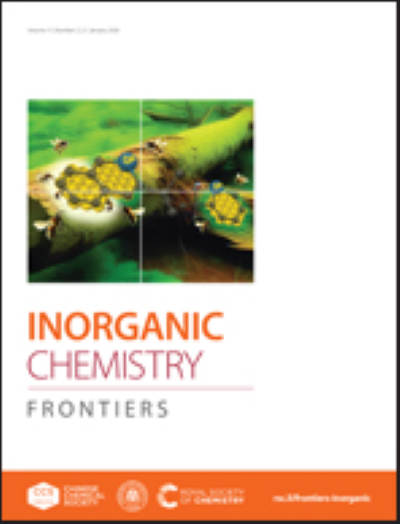Insights into the Intricate Charge Photoaccumulation in a Polyoxometalate–Bodipy Covalent Hybrid
IF 6.4
1区 化学
Q1 CHEMISTRY, INORGANIC & NUCLEAR
引用次数: 0
Abstract
Solar fuel generation relies on the catalysis of multielectron, multiproton reactions facilitated in nature by charge accumulation in electron relays like NADPH or hydroquinone. Here, we demonstrate the light-driven charge accumulation in a noble-metal-free photochemical dyad comprising a bodipy photosensitizer linked to a Dawson polyoxometalate (POM) using triethylamine (TEA) as sacrificial electron donor. Under visible light irradiation, the hybrid dyad accumulates up to two electrons on the POM, achieving complete conversion within few minutes. The first reduction proceeds rapidly and efficiently while the second electron is introduced more slowly through an intricate, multi-pathway mechanism that we inferred through combined spectroscopy, electrochemistry and theoretical calculations. The formation of the two-electron reduced species is enhanced in the presence of trifluoroacetic acid by virtue of proton-coupled electron transfer (PCET) as well as by promoting the dismutation of the one-electron reduced POM. Simultaneously, POM reduction may also take place via a light-independent route involving the reactive TEA radical byproduct, effectively rendering TEA an overall two-electron, one-proton donor. The stored redox equivalents in the POM were demonstrated to activate oxygen but also to be engaged in PCET to substrates such as 1,4-benzoquinone, highlighting the potential utility of POM-photosensitizer hybrids in solar fuel-related transformations.多金属氧酸-体二聚共价杂合体复杂电荷光积累的研究
太阳能燃料的产生依赖于自然界中由NADPH或对苯二酚等电子继电器中的电荷积累促进的多电子、多质子反应的催化。在这里,我们展示了用光驱动电荷积累在一个无贵金属的光化学二元体中,该二元体包括一个与道森多金属氧酸盐(POM)连接的光敏剂,使用三乙胺(TEA)作为牺牲电子供体。在可见光照射下,混合二极体在POM上积累了多达两个电子,在几分钟内实现了完全转换。第一次还原进行得迅速而有效,而第二个电子通过一个复杂的多途径机制引入得更慢,我们通过综合光谱、电化学和理论计算推断。在三氟乙酸的存在下,通过质子耦合电子转移(PCET)以及通过促进单电子还原POM的突变,增强了双电子还原种的形成。同时,POM的还原也可以通过不依赖光的途径进行,其中包括活性的TEA自由基副产物,有效地使TEA成为一个整体的双电子、一质子供体。POM中储存的氧化还原等价物被证明可以激活氧气,但也可以与1,4-苯醌等底物进行PCET,突出了POM-光敏剂混合物在太阳能燃料相关转化中的潜在用途。
本文章由计算机程序翻译,如有差异,请以英文原文为准。
求助全文
约1分钟内获得全文
求助全文
来源期刊

Inorganic Chemistry Frontiers
CHEMISTRY, INORGANIC & NUCLEAR-
CiteScore
10.40
自引率
7.10%
发文量
587
审稿时长
1.2 months
期刊介绍:
The international, high quality journal for interdisciplinary research between inorganic chemistry and related subjects
 求助内容:
求助内容: 应助结果提醒方式:
应助结果提醒方式:


